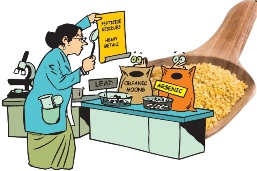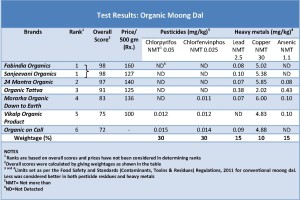Feb.18: COVER STORY
- Posted by CERC India
- Posted in February
Toxic pesticides and heavy metals in organic moong dal
Pesticide residues found in 3 of 7 brands tested, heavy metals in all brands
We believe organic food products are safe and good for health. That’s why we are willing to pay that extra amount to buy them. But when a staple like organic moong dal, which is widely used in India, has pesticides and heavy metals we feel cheated and alarmed.
Our tests
The brands were tested for safety parameters – presence of heavy metals and pesticide residues. The 3 heavy metals tested were – lead, copper and arsenic. We tested the products for 16 pesticides – 5 of the organochloride group and 11 of the organophosphate group. Of these, 14 were not detected in any of the brands. The two detected belonged to the organophosphate group.
Pesticide residues: Trace levels of pesticide residues were present in 3 out of 7 brands of organic moong dal. The pesticides found were chlorpyrifos and chlorfenvinphos. They are not in the US list of pesticides permitted in organic products. The brands in which they were detected were Morarka Organic, Organic on Call and Vikalp Organic Product. (See table for detailed results.)Â
As is known, over a long duration, even microscopic quantities of pesticides can harm as they get accumulated in the body. Chlorpyrifos, detected in two brands, has been linked with delays in learning, reduced physical coordination and behavioural problems in children. Chlorfenvinphos, detected in three brands, is an insecticide which if ingested can affect the central nervous system adversely.
Heavy metals: Varying amounts of lead, copper and arsenic were found in the brands. Lead levels ranged from 0.07-0.38 mg/kg, copper ranged from 2.02-6.00 mg/kg and arsenic ranged from 0.08-0.43 mg/kg. (See table for detailed results.)
Lead is a toxic metal hazardous for children. It can accumulate in the body and harm almost every organ system. Hence, even low levels of exposure can be harmful. Very large single or long-term intakes of copper may cause male infertility. Long-term exposure to arsenic from food can cause cancer and cardiovascular disease.
How can the limits be the same?
Since there are no specific standards for organic food in India at present, we tested the samples as per the limits set by the Food Safety and Standards (Contaminants, Toxins & Residues) Regulations, 2011, for conventional moong dal.
The levels of pesticides and heavy metals in the organic moong dal brands were within the limits prescribed for conventional moong dal. But how can we have the same limits for organic food and conventional food? The very rationale of buying organic food for a consumer is buying a product free of pesticides and other harmful elements.
FSSAI launches logo, portal for organic food products
The Food Safety and Standards Authority of India (FSSAI) recently unveiled a logo for organic food products – Jaivik Bharat – along with the Food Safety and Standards (Organic Foods) Regulations 2017. Under these regulations, organic foods are required to comply with the requirements of National Programme for Organic Production (NPOP) or Participatory Guarantee System for India (PGS-India) of the Ministry of Agriculture and Farmers Welfare. However, direct sales of organic food by small farmers, producers or producer organisations to the end-consumer is exempt from this requirement. The regulations will come into effect on July 1, 2018. With respect to standards on residues of insecticides, organic food will have to comply with much stricter standards of 5% of the limit for non-organic food.
FSSAI action inadequate
Based on its findings in earlier tests, CERC had urged the Food Safety and Standards Authority of India (FSSAI) to set mandatory standards specifically for organic foods. We welcome FSSAI’s recent move to make insecticide limits more stringent for organic foods as a step in the right direction. However, we do feel it is too little.
Why has FSSAI restricted itself to insecticides? Why not set stringent norms for pesticides and heavy metals as well? FSSAI’s non-inclusion of these critical culprits is mystifying. We are also unable to understand the rationale behind FSSAI giving exemption to direct sales of organic food to the end-consumer by small farmers, producers or producer organisations. If small farmers and producers do not have to follow the regulations won’t this hurt the consumer?
Variety of logos: While the intention behind multiple certifications and logos is to assure quality by the manufacturer, it could be confusing for consumers. For instance, Sanjeevani had five certifications!
How the brands performed
To enable consumers to make an informed choice, we compared the test results for organic moong dal and organic rice. The brands were the same. Sanjeevani Organics and 24 Mantra Organic showed a better overall performance in moong dal than in rice. As far as individual safety parameters go, all the brands contained lead and copper in amounts similar to that in organic rice. Fabindia Organics was the most consistent in performance and fared well in both moong dal and rice.
Manufacturers’ response
As a policy, we convey the test results to all the manufacturers and await their response. We received the following responses relevant to organic moong dal:
Sanjeevani Organics: Organic certification was done for the practices and processes and not for the products.
Grahak Sathi: Consumers are concerned not with processes and practices but with the end product. Certification for processes must reflect in quality of final product.
Organic Tattva: As per APEDA (Agricultural and Processed Food Products Export Development Authority) guidelines there is no requirement for testing of heavy metals for organic products.
Grahak Sathi:Â True. However, we have tested for them as consumers should be concerned about their presence in foods. Heavy metals accumulate in the human body over a period of time and cause harm.
Areas of action
We have made a representation to FSSAI urging it to:
- Formulate stringent limits for pesticides and heavy metals in organic foods
- Ensure that small farmers, producers or producer organisations who sell directly to the end-consumer not be given exemption from following the regulations
- Ensure that NPOP extends to product certification
- Regularly monitor organic food quality, including that sold online
- Closely monitor advertising claims made by organic food manufacturers
Grahak Sathi’s conclusion
The objectives of the testing were to investigate whether organic brands of moong dal are safer and healthier to consume compared to the non-organic brands. The test findings proved that this is not so. Also, organic moong dal is much more expensive.
A comparison of the 7 organic brands show that Sanjeevani Organics and Fabindia Organics (higher in price) both obtained the highest overall score as they had no pesticides and heavy metals were within limits.
Â






